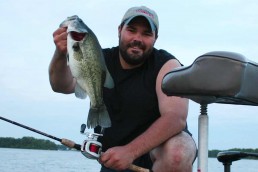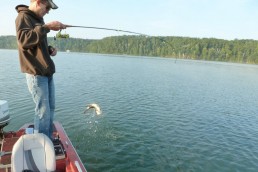Forgotten Fish: Mining Deep Water for Unpressured Bass
SHARE THIS POST
Most black bass fishing is done in fairly shallow water. There exists, however, another realm in the world of bass fishing, a place where few anglers visit on a routine basis, a zone that can harbor numbers of these fish, and some beasts as well. On virtually all bodies of water, at least some of the bass population will use deep water for at least a few months of the year. On some waters though, the majority of bass will utilize the deep-water areas most of the year.
Regardless of the waters we choose to pursue our favorite quarry on, to be consistent throughout the year we must familiarize ourselves with the tactics used to haul in the bass from the depths.
Waters and seasons
Clear waters, or the clearer sections of stained lakes and reservoirs, are the locations where deep-bassin’ tactics are at their finest. Usually, the clearer the water, the more bass will utilize deeper water for long periods. Depth provides security, and clear-water fish tend to be spookier than their dirty water counterparts. Smallmouths and spotted bass tend to hang deeper than largemouths do, but truly deep water can harbor some of the biggest bucketmouths in a lake.
Bass in all waters can use deep water throughout the year, but the dirtier lakes with a moderate to heavy stain will hold a larger population of bass. Exceptions to this have a lot to do with the time of year and water temperature. Summer and winter are the best times for a deep-bass hunt, and extremes in temperatures move fish to deeper structure and even cause the bass to suspend. When temperatures surpass 80 degrees or drop below 50, it’s time to expect to find a good deep-water bass bite on a lake—just remember that the clearer the water, the deeper most bass will hold and that they move to even deeper water.
The term “deep” can vary from lake to lake. On slightly stained water lakes with clear sections and a maximum depth of just 70 or so like Kinkaid Lake in Illinois, “deep” is considered anything over 15 feet. Large swamps and backwater bayous throughout the South and the many farm ponds and small lakes that speckle the Midwest have a maximum depth of 15 to 20 feet so the 10-foot depth zones or even shallower can be considered deep water.
On a clear reservoir, such as Missouri’s Table Rock Lake where the depths drop to around 200 feet, it takes at least 30 to 40 feet of water or more to be considered deep. In the eastern basin of Lake Erie near Buffalo, 20 feet of water or more is thought of by many as “deep,” while deep-water bass fishing takes place on Wisconsin’s Chippewa Flowage in water over 15 feet.
Location
Most of the time, bass in deeper waters relate to structure. These are best that have cover on them. Timber, stumps, brush piles, boulders and chunk rock or shelf rock provide great cover for these predators, and their prey. Natural lakes in the North and a growing number of man-made waters throughout the region have native or non-native aquatic vegetation that can grow in surprisingly deep water. These weeds and grasses make perfect ambush locations where predator fish can lie in wait for their unsuspecting prey. Some bass will also school up and suspend in the water column over deep water where they commonly hunt schools of pelagic baitfish such as shad.
Maps and electronics will greatly aid in the search for these bass. Maps can get you into the right areas by showing the available structures to target. Once there, a sonar unit will help pick out the spot or a unique feature or features on the structure likely to hold the most and GPS can get you back there quickly on the return. Sonar is also great for locating those schools of cruising bait and bass in open water.
Are you enjoying this post?
You can be among the first to get the latest info on where to go, what to use and how to use it!
Presentation
A variety of presentations work in a various depths, but deep-water bass usually involve slow retrieves. Most lure options for deeper water actually require a slow or moderate retrieve to keep the offering in the strike zone. If sinking lures are worked too fast they won’t stay down. With floating/diving styles, a retrieve that’s too fast often causes them to veer off to the side and they won’t attain the maximum diving depth. It’s true that speed can be a powerful trigger that we lose when targeting the deep fish, but moderate and slow presentations can be effective too. Often, the neutral or negative mood of a fish will cause it to respond better to a slower approach, but even active and aggressive bass can be tempted with a slow presentation, especially when it is a large one. Long-bill crankbaits, heavy spinner baits, big jigs and heavy spoons or weighted plastics are all effective.
The size factor
Lure size plays an important part. The fact that we have to get our offering into the strike zone of bass positioned far beneath the water’s surface means we must use heavily weighted lures quite often. The heavy lures get us down to the fish without wasting time and allows us to stay there and maintain contact with the bottom, which is critical. Even when choosing lures in the floating/diving spectrum, the deeper-running lures are also the largest.
While there are times when employing downsized presentations is the most effective way to proceed, often, the big presentations are just as good a choice, if not better. There is a theory that big baits catch big fish. This is certainly true, at least for a good portion of the time. Bigger bass feed less often than smaller bass, therefore when they do want to eat they usually want a substantial meal. What all this boils down to is more weight gain with less energy spent. This might not be the best advice in our world, but it certainly makes perfect sense if you are a bass underwater. Deep water is a frontier that all anglers can benefit greatly from venturing into, and it’s a great place to target big bass year ‘round.
Get out there
God’s great outdoors and the magnificent creatures He’s created for us to share this world with, like these bass, await us in the wild. It’s a place where we can literally restore our souls from the stresses of this complicated world today. Let the natural world give you back what’s stolen away in an average day, and, don’t forget to take advantage of a little deep-water bass when when you get out there.
Colby Simms displays a nice bass taken from the depths.
Ray Simms with a monster largemouth taken slow-trolling deep water with the Colby Simms Outdoors Hatchet Spin.
Colby Simms shows that smallmouths love deep water too. Photos: The Colby Simms Outdoors Team
MWO
SHARE THIS POST
You may also like...
0 CommentsGreat Shallow-water Bass Action Right Now
Did you enjoy this post?
You can be among the first to get the latest info on where to go, what to use and how to use it!
Colby Simms
Colby Simms is a professional fisherman, media personality, guide and owner of Colby Simms Outdoors Group. He runs a guide service booking guided fishing and hunting trips, and sells tackle. Contact him at colbysimmsoutdoors@hotmail.com, Facebook @ColbySimmsOutdoors and @ColbySimmsSportFishingPro, or 618-521-0526 or 573-358-5948.


